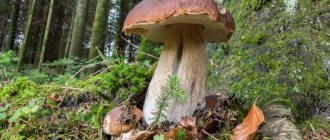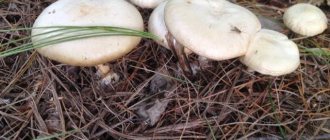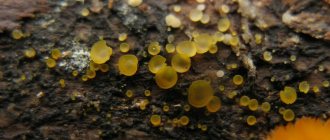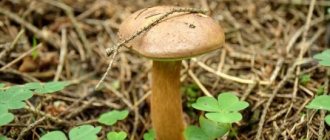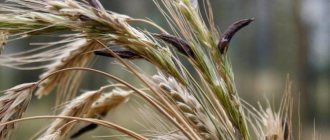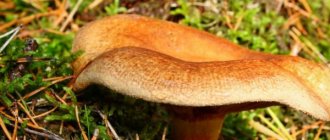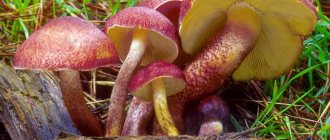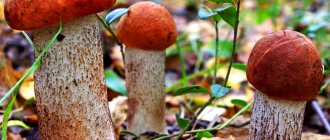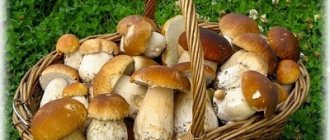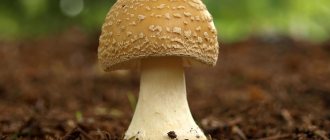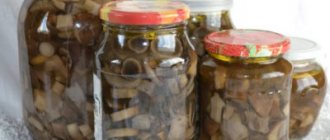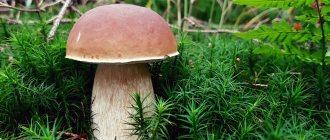Not all mushrooms are equally beneficial. Some are completely poisonous and can cause severe poisoning. To prevent this from happening, you need to know the main differences between edible mushrooms and inedible and poisonous ones.
All mushrooms are divided into edible, conditionally edible (or inedible) and poisonous. Conditionally edible mushrooms do not always lead to poisoning. At the same time, those mushrooms that can be eaten can also cause harm to the body; it’s just that the rules for collecting, preparing or storing them were violated, which caused unpleasant consequences.
Conditionally edible mushrooms can be safely eaten after prolonged cooking. For example, milk mushrooms, morels, and autumn mushrooms, which belong to this category of mushrooms, should be boiled for at least 40 minutes and then rinsed with hot water.
Eating poisonous mushrooms can lead to severe poisoning and even death. Therefore, it is worth knowing the difference between edible mushrooms and poisonous ones.
Unfortunately, there are no clear signs of this difference. Although you will probably recognize the bright red fly agarics with characteristic white specks on the cap, because you have seen them more than once on the pages of children's books. But many poisonous mushrooms do not have this color. Therefore, other evaluation “criteria” will have to be used. One of the most characteristic features of the toadstool and many fly agarics is the so-called “pot”, or volva. The mushroom stem seems to grow from this very pot.
A reliable sign of edible mushrooms is the spongy structure of the cap. Among the representatives of the “poisonous” family, such a structure is characteristic only of the satanic mushroom, which is very similar to the boletus mushroom. They are distinguished by their cap.
False varieties of edible mushrooms, on the contrary, have a lamellar cap structure, characteristic of most inedible mushrooms. But still, most inedible mushrooms are very similar to edible ones. Therefore, we will consider their most characteristic differences.
How to identify poisonous mushrooms - the most reliable method
People have many ways to test mushrooms for toxicity, but all of them are unreliable and are designed to detect a single poison. Accurate identification is possible only on the basis of characteristic features by which deadly types of mushrooms can be accurately identified. If you come across a dubious specimen whose identification you doubt, proceed as follows: Look at the inside of the cap to determine whether the unidentified specimen belongs to lamellar or tubular mushrooms. All the most poisonous mushrooms are lamellar. For example, fly agarics and toadstools. Therefore, be especially wary of such mushrooms. Look carefully at the bottom of the mushroom. Fly agarics and toadstools of all varieties have an ovoid thickening in the lower part of the leg. Look to see if there is a collar ring on the leg. It is located approximately in the middle - a little closer to the cap. If the mushroom has a “skirt,” throw it away as soon as possible.
When does the 2016 mushroom season begin?
Depending on climatic conditions, the mushroom season in our latitudes begins in mid-April or early May. The height of the season is in August and early September, when there are especially many mushrooms. In the table below you will see a mushroom calendar, from which you can approximately determine the period of growth and collection of certain types of edible mushrooms:
Fewer and fewer mushrooms will be found in October, but in fact the 2016 mushroom season will end with the complete end of autumn and the onset of winter.
Misconceptions about recognizing edible and poisonous mushrooms
The people have several signs for identifying poisonous individuals, and many of them are erroneous. For example: Edible specimens are believed to be pleasant to the taste. Not true - fly agaric mushrooms are also tasty. Young fungi are safe; toxicity comes with age. This is not true, especially regarding the toadstool - it is deadly at any age. Poisonous mushrooms smell unpleasant. Nothing like this. Many poisonous and conditionally edible specimens have a pleasant aroma, while many have no odor at all. Representatives of the inedible category usually have an unpleasant odor. There is a widespread belief that poisonous mushrooms are not wormy - they are supposedly not to the taste of insects. Taking mushrooms that have been eaten away by worms and nibbled by snails into a basket, mushroom pickers think that these mushrooms are definitely edible. In fact, insects can live in any mushroom. Many are sure that alcohol neutralizes poison. Not true again. This misconception is especially dangerous - alcohol, on the contrary, contributes to the intoxication of the body with mushroom poison. If you drink poisonous mushrooms with alcohol, the likelihood of death increases. The opinion about the benefits of boiling mushrooms is also erroneous - boiling does not get rid of all poisons. There are toxins that are neutralized after boiling, and there are others that are resistant to high temperatures.
Equipment for a beginner mushroom picker
When planning to go mushroom picking, you need to choose equipment that can protect you from annoying insects, in particular ticks and mosquitoes, will prevent you from getting hurt by protruding tree branches and will save you from sudden rain. Always wear a hat - it will protect you from heat and sunstroke, dust, moisture and cold.
During the hot summer season, choose closed, light-colored clothing and even then protect your neck with a light scarf. Shoes must completely cover the foot. In rainy weather, wear a raincoat and rubber boots.
Prepare a wicker basket - this is the best option to let your crop “breathe”. In the bag, mushrooms can “suffocate” and break. Also bring a sharp knife, compass and watch.
Control check
0
Source:
They don’t store mushroom trophies - as soon as they come from the forest, they immediately get to work - clean, wash and cook. A few hours will pass and all the loot will be spoiled. During cleaning, the mushrooms are carefully inspected so that not a single poisonous one slips through. Put old specimens aside - after cooking they will soften and be tasteless, they can even cause poisoning.
0
Source:
Popular “testing” People have come up with a lot of methods that allow them to identify poisonous representatives of the mushroom world. Unfortunately, many of them are not effective, since they are designed for the reaction of a specific poison or group of poisons. Moreover, many methods are erroneous, and the price of error is human lives. Let's figure out what methods there are, what exactly they define, and why they cannot be trusted. Testing with silver There is a popular belief that toxicity can be detected using silver objects. This is a flawed method that should not be relied upon. Silver darkens not from poisons, but from certain amino acids, which can be contained in any mushrooms, regardless of their edibility. Checking with garlic and onions Mushroom pickers have another way to check for quality - already during cooking. Throw an onion or garlic into the pan. If there is a poisonous specimen there, they turn blue. I have to throw away undercooked soup. But onions or garlic turn brown not at all from poison, but because of tyrosinase - this is a special enzyme that has no connection with edibility - it can be contained in both toxic and edible specimens. What will the insects tell you? Among some mushroom pickers there is a belief that poisonous mushrooms are not eaten by insects. In fact, the presence of insects does not mean anything - among them there are species resistant to poisons. Testing with milk It is believed that milk that gets on the body of a poisonous mushroom will curdle. In fact, folding is caused by the enzyme pepsin, which can be found in any form - edible and toxic. Vinegar test It is believed that boiling in a solution of vinegar and salt helps neutralize toxins. Indeed, this is how you can protect slightly toxic species, for example, stitches. But such manipulations are not scary for the pale grebe; its poison remains strong no matter how it is processed. Recognition by color of plates Color of subcap plates. The pinkish plates are said to indicate harmlessness. Not certainly in that way. It’s true that the champignon has pink plates, but the yellowing champignon and entoloma, both poisonous species, also have a pinkish tint. Recognition by fault Fault color. It is believed that if the color of the flesh at the break suddenly turns red or purple, there is poison in the mushroom body. But, for example, edible hornbeams turn purple on the fault, and hornbeams turn blue.
Comparison of similar species
Many varieties of poisonous mushrooms are skillfully disguised as edible ones, and this is precisely their main danger. Therefore, you should learn to distinguish between such fruits in order to avoid adverse consequences in the future.
Honey mushrooms
Both false and real honey mushrooms grow mainly in the same places. For this reason, distinguishing them can be extremely problematic.
Helpful advice!
You should not collect those mushrooms that grow on the ground.
When picking fruits, you need to pay attention to their cap. In the real honey mushroom it is dark brown and scaly. The true fruit also has a small skirt.
The false mushroom has a mostly smooth cap surface and no skirt. When an inedible honey mushroom is broken, an unpleasant odor occurs.
Butter
Edible boletus got its name due to the characteristics of its caps. It has a glossy surface, when touched it is sticky and slippery. The hat seems to be generously poured with oil, so it is shiny. If you lightly pry the surface with a knife or fingernail, it comes off easily. When cut, the true butterfly remains yellowish, while the false mushroom turns red or blue.
Chanterelles
False chanterelles are very similar to true ones, so an inexperienced mushroom picker may have difficulty recognizing them.
A real chanterelle is orange or pale pinkish in color. The stem and cap are the same color. The shape of the legs and cap edges is corrugated.
The false specimen has a reddish tint to the leg, and its structure is hollow. The hat has smoother edges. Its color is brighter than that of the real, edible chanterelle mushroom. If you break the pulp, a whitish discharge appears on its surface.
Champignon
You can distinguish a true champignon from a false one by appearance. To do this, you need to look under the cap, and then cut the mushroom in half.
But sometimes the common features of these fruits appear so clearly that it is difficult to distinguish them even by their characteristic features. In this case, you need to break the fruit and smell it. The false champignon has an unpleasant, repulsive odor. At the same time, the true edible fruit has a rather pleasant, mushroom-like appearance.
Bile mushroom
The inexperience of a novice mushroom picker makes itself felt the moment he encounters a gall fungus. This fruit is very similar to boletus or boletus.
Thus, the gall fungus has tubes colored pinkish-brown. At the same time, in boletus they are usually just yellow. On the fault, the cap of the double is pinkish, while on the true mushroom it never looks like this.
Can you get poisoned by edible mushrooms?
0
Source:
Even edible mushrooms can easily lead to poisoning. The reasons for the transformation of such mushrooms into a poisonous product: Bacteria. Once in the nutrient medium - the mushroom body, the bacteria multiply intensively. Sources of infection are soil, transportation containers, dirty hands. If mushrooms are not processed properly, you can develop bacterial poisoning. If mushrooms are fried or boiled, the bacteria are almost 100% killed. But salted mushrooms can fail if they were not prepared correctly - they lay in the same water for a long time, the ambient temperature was high, or they did not add enough salt to the marinade. Botulism. This scourge affects canned foods. The culprits of infection are clostridia spores. Pickled mushrooms stored without access to air can cause botulism. Toxins. Mushrooms, like sponges, absorb all the chemicals that surround them. Together with mushrooms grown somewhere in an industrial area or near farmland, heavy metals, herbicides, etc. can enter the body, causing severe intoxication. Binge eating. Mushrooms are considered heavy food. Their consumption should be moderate. And for people with gastrointestinal problems, kidney and liver diseases, they are generally contraindicated.
The poisonous twin of summer honey mushrooms: sulfur-yellow honey fungus
Everyone knows that honey mushrooms grow on stumps in friendly flocks, but among them there is a “relative” that looks practically no different from tasty mushrooms, but causes severe poisoning. This is a false sulfur-yellow honey fungus. Poisonous lookalikes live in clusters on the remains of tree species almost everywhere, both in forests and in clearings between fields.
Fragile impatiens galerina swamp
In marshy areas of the forest, in thickets of moss, you can find small mushrooms on a long thin stalk - marsh galerina. The brittle light yellow leg with a white ring at the top can be easily knocked down even with a thin twig. Moreover, the mushroom is poisonous and should not be eaten anyway. The dark yellow cap of the galerina is also fragile and watery. At a young age it looks like a bell, but then straightens, leaving only a sharp bulge in the center.
